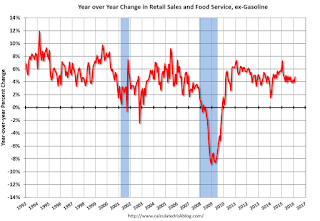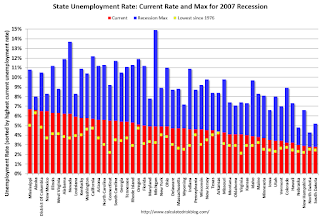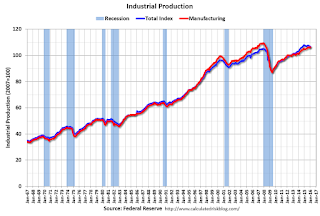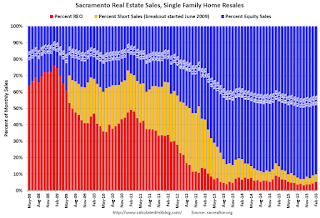by Calculated Risk on 3/15/2016 10:05:00 AM
Tuesday, March 15, 2016
NAHB: Builder Confidence unchanged at 58 in March
The National Association of Home Builders (NAHB) reported the housing market index (HMI) was at 58 in March, unchanged from 58 in February. Any number above 50 indicates that more builders view sales conditions as good than poor.
From the NAHB: Builder Confidence Holds Steady in March
uilder confidence in the market for newly-built single-family homes was unchanged in March at a level of 58 on the NAHB/Wells Fargo Housing Market Index (HMI).
“Confidence levels are hovering above the 50-point mid-range, indicating that the single-family market continues to make slow but steady progress,” said NAHB Chairman Ed Brady. “However, builders continue to report problems regarding a shortage of lots and labor.”
“While builder sentiment has been relatively flat for the last few months, the March HMI reading correlates with NAHB’s forecast of a steady firming of the single-family sector in 2016,” said NAHB Chief Economist David Crowe. “Solid job growth, low mortgage rates, and improving mortgage availability will help keep the housing market on a gradual upward trajectory in the coming months.”
...
The HMI component gauging current sales conditions held steady at 65 in March while the index measuring sales expectations in the next six months fell three points to 61. The component charting buyer traffic rose four points to 43.
Looking at the three-month moving averages for regional HMI scores, the Midwest posted a one-point gain to 58 while the South was unchanged at 59. The West registered a three-point decline to 69 while the Northeast fell one point to 46.
emphasis added
 Click on graph for larger image.
Click on graph for larger image.This graph show the NAHB index since Jan 1985.
This was below the consensus forecast of 59, but still a strong reading.
Retail Sales decreased 0.1% in February
by Calculated Risk on 3/15/2016 08:49:00 AM
On a monthly basis, retail sales were down 0.1% from January to February (seasonally adjusted), and sales were up 3.1% from February 2015.
From the Census Bureau report:
The U.S. Census Bureau announced today that advance estimates of U.S. retail and food services sales for February, adjusted for seasonal variation and holiday and trading-day differences, but not for price changes, were $447.3 billion, a decrease of 0.1 percent from the previous month, and 3.1 percent above February 2015. ... The December 2015 to January 2016 percent change was revised from up 0.2 percent to down 0.4 percent (
 Click on graph for larger image.
Click on graph for larger image.This graph shows retail sales since 1992. This is monthly retail sales and food service, seasonally adjusted (total and ex-gasoline).
Retail sales ex-gasoline were up 0.2%.
The second graph shows the year-over-year change in retail sales and food service (ex-gasoline) since 1993.
 Retail and Food service sales ex-gasoline increased by 4.8% on a YoY basis.
Retail and Food service sales ex-gasoline increased by 4.8% on a YoY basis.The decrease in February was at expectations, however retail sales for December were revised down. Even though disappointing (including revisions), sales ex-gasoline are up a solid 4.8% YoY.
Monday, March 14, 2016
Tuesday: Retail Sales, PPI, NY Fed Mfg Survey, Homebuilder Confidence
by Calculated Risk on 3/14/2016 05:43:00 PM
From Matthew Graham at Mortgage News Daily: Mortgage Rates Remain Near Recent Highs
Mortgage rates moved slightly lower today, for the second time in March. Unfortunately, the improvement did little to erase the recent weakness, which, as of Friday, had carried rates to their highest levels since late January. We're essentially still right there, but with slightly improved closing costs, depending on the lender. The most prevalent conventional 30yr fixed quotes remain in a range of 3.75% to 3.875% for top tier scenarios.Tuesday:
emphasis added
• At 8:30 AM ET, Retail sales for February will be released. The consensus is for retail sales to decrease 0.1% in February.
• Also at 8:30 AM, the Producer Price Index for February from the BLS. The consensus is for a 0.2% decrease in prices, and a 0.1% increase in core PPI.
• Also at 8:30 AM, the NY Fed Empire State Manufacturing Survey for March. The consensus is for a reading of -11.0, up from -16.7.
• At 10:00 AM, the March NAHB homebuilder survey. The consensus is for a reading of 59, up from 58 in February. Any number above 50 indicates that more builders view sales conditions as good than poor.
• Also at 10:00 AM, Manufacturing and Trade: Inventories and Sales (business inventories) report for January. The consensus is for no change in inventories.
FOMC Preview and Review of Projections
by Calculated Risk on 3/14/2016 01:01:00 PM
Almost all analysts are expecting no change in Fed policy at the March FOMC meeting this week. Currently the Fed Funds target rate is the range of "1/4 to 1/2 percent".
The current effective rate is 0.36 percent, close to the middle of the current range.
The focus this month will be on the wording of the statement, any changes to the projections, and on the press conference.
In the December statement, the FOMC characterized the risks to the economy as "balanced":
Overall, taking into account domestic and international developments, the Committee sees the risks to the outlook for both economic activity and the labor market as balanced."Balanced" was removed in the January statement. Based on incoming data, many analysts expect the FOMC to add "balanced" back to the March statement (preparing to raise rates in June or even April).
As example, from Goldman Sachs:
We do not think the committee is ready to raise rates next week, but expect the statement to say that risks are “nearly balanced”. Guidance from the meeting in general should indicate that another rate hike is likely before too long—we expect an increase at the June 14-15 FOMC meeting, but action at the April 26-27 meeting is not inconceivable.And some comments from Merrill Lynch:
The March meeting will include an updated Summary of Economic Projections (SEP), to be released at 2 PM. We expect the updated dot plot will show a median of three hikes for this year (with a number of dots at two hikes) and four for 2017. In this sense, not hiking in March is similar to last September’s “tactical delay” of liftoff. The opening paragraph of the statement and Yellen’s subsequent press conference remarks should note that the US data recently have shown improvement on net. Indeed, we expect some signs of optimism in the discussion of the outlook going forward, supporting the Fed’s forecast for additional hikes later this year. April should remain a “live” meeting.Here are the December FOMC projections. Since the release of those projections, Q4 GDP was reported at a 1.0% annual rate. That put GDP up 1.9% Q4 2015 over Q4 2016 (Note: GDP was up 2.4% in 2015 compared to 2014, but the Fed projects Q4 over Q4).
Currently GDP is tracking around 2.2% annualized in Q1. The FOMC might revise down GDP for 2016 slightly.
| GDP projections of Federal Reserve Governors and Reserve Bank presidents | ||||
|---|---|---|---|---|
| Change in Real GDP1 | 2015 | 2016 | 2017 | 2018 |
| Dec 2015 | 2.1 | 2.3 to 2.5 | 2.0 to 2.3 | 1.8 to 2.2 |
| Sept 2015 | 2.0 to 2.3 | 2.2 to 2.6 | 2.0 to 2.4 | 1.8 to 2.2 |
The unemployment rate was at 4.9% in February, so the unemployment rate projection for Q4 2016 will probably be unchanged.
| Unemployment projections of Federal Reserve Governors and Reserve Bank presidents | ||||
|---|---|---|---|---|
| Unemployment Rate2 | 2015 | 2016 | 2017 | 2018 |
| Dec 2015 | 5.0 | 4.6 to 4.8 | 4.6 to 4.8 | 4.6 to 5.0 |
| Sept 2015 | 5.0 to 5.1 | 4.7 to 4.9 | 4.7 to 4.9 | 4.7 to 5.0 |
As of January, PCE inflation was up only 1.3% from January 2015. Overall PCE inflation projections might be revised up slightly for 2016.
| Inflation projections of Federal Reserve Governors and Reserve Bank presidents | ||||
|---|---|---|---|---|
| PCE Inflation1 | 2015 | 2016 | 2017 | 2018 |
| Dec 2015 | 0.4 | 1.2 to 1.7 | 1.8 to 2.0 | 1.9 to 2.0 |
| Sept 2015 | 0.3 to 0.5 | 1.5 to 1.8 | 1.8 to 2.0 | 2.0 |
PCE core inflation was up 1.7% in January year-over-year. It appears core PCE inflation will be revised up slightly for 2016.
| Core Inflation projections of Federal Reserve Governors and Reserve Bank presidents | ||||
|---|---|---|---|---|
| Core Inflation1 | 2015 | 2016 | 2017 | 2018 |
| Dec 2015 | 1.3 | 1.5 to 1.7 | 1.7 to 2.0 | 1.9 to 2.0 |
| Sept 2015 | 1.3 to 1.4 | 1.5 to 1.8 | 1.8 to 2.0 | 1.9 to 2.0 |
Overall, it appears the labor market has improved, and the economy is growing about as expected - and inflation is slowly moving towards the Fed's target.
BLS: Unemployment Rate decreased in 28 States in January
by Calculated Risk on 3/14/2016 10:10:00 AM
From the BLS: Regional and State Employment and Unemployment Summary
Regional and state unemployment rates were little changed in January. Twenty-eight states and the District of Columbia had unemployment rate decreases from December, 8 states had increases, and 14 states had no change, the U.S. Bureau of Labor Statistics reported today.
...
North Dakota and South Dakota had the lowest jobless rates in January, 2.8 percent each, closely followed by New Hampshire, 2.9 percent. Mississippi had the highest rate, 6.7 percent, followed by Alaska, 6.6 percent.
 Click on graph for larger image.
Click on graph for larger image.This graph shows the current unemployment rate for each state (red), and the max during the recession (blue). All states are well below the maximum unemployment rate for the recession.
The size of the blue bar indicates the amount of improvement. The yellow squares are the lowest unemployment rate per state since 1976.
The states are ranked by the highest current unemployment rate. Mississippi, at 6.7%, had the highest state unemployment rate.
 The second graph shows the number of states (and D.C.) with unemployment rates at or above certain levels since January 2006. At the worst of the employment recession, there were 11 states with an unemployment rate at or above 11% (red).
The second graph shows the number of states (and D.C.) with unemployment rates at or above certain levels since January 2006. At the worst of the employment recession, there were 11 states with an unemployment rate at or above 11% (red).Currently no state has an unemployment rate at or above 7% (light blue); Only eight states are at or above 6% (dark blue).
Sunday, March 13, 2016
Sunday Night Futures
by Calculated Risk on 3/13/2016 08:16:00 PM
Gasoline prices have been increasing in most areas. As an example, from the LA Daily News: Southern California gas prices rise sharply again
The average price of a gallon of self-serve regular gasoline in Los Angeles County rose 3.5 cents Saturday to $2.693, one day after increasing 5 cents.Weekend:
The average price has risen 16 consecutive days, increasing 33.2 cents, according to figures from the AAA and Oil Price Information Service. It is 11.6 cents higher than one week ago and 12.2 cents greater than one month ago.
• Schedule for Week of March 13, 2016
• Goldman: FOMC Preview
Monday:
• At 10:00 AM ET, Regional and State Employment and Unemployment (Monthly) for January 2016 from BLS.
From CNBC: Pre-Market Data and Bloomberg futures: currently S&P futures are down 4 and DOW futures are down 29 (fair value).
Oil prices were up over the last week with WTI futures at $38.44 per barrel and Brent at $40.39 per barrel. A year ago, WTI was at $45, and Brent was at $55 - so prices are down about 15% to 25% year-over-year, respectively.
Here is a graph from Gasbuddy.com for nationwide gasoline prices. Nationally prices are at $1.94 per gallon (down about $0.50 per gallon from a year ago).
Goldman: FOMC Preview
by Calculated Risk on 3/13/2016 12:47:00 PM
A few excerpts from a research piece by Goldman Sachs economists Zach Pandl and Jan Hatzius: March FOMC Preview
At its meeting in late January, the FOMC suspended its normal balance of risks assessment over concerns about tighter financial conditions and downside risks to growth. Although policymakers continue to express some caution about the outlook, financial conditions have eased considerably over the last month, and incoming data have held up reasonably well.
We do not think the committee is ready to raise rates next week, but expect the statement to say that risks are “nearly balanced”. Guidance from the meeting in general should indicate that another rate hike is likely before too long—we expect an increase at the June 14-15 FOMC meeting, but action at the April 26-27 meeting is not inconceivable.
...
Beyond next week’s meeting, we think markets may be underestimating Fed officials’ tolerance for tighter financial conditions over time. In fact, we expect that financial conditions will need to tighten moderately over the next year to bring employment growth to a trend pace, which probably requires a steeper funds rate path than currently priced in the bond market.
emphasis added
Saturday, March 12, 2016
Schedule for Week of March 13, 2016
by Calculated Risk on 3/12/2016 08:11:00 AM
The key economic reports this week are February retail sales on Tuesday, and February housing starts on Wednesday.
For prices, PPI and CPI will be released this week.
From manufacturing, February Industrial Production and the March NY and Philly Fed manufacturing surveys will be released this week.
The FOMC meets this week, and the FOMC statement (and press conference) will be on Wednesday.
10:00 AM ET: Regional and State Employment and Unemployment (Monthly) for January 2016 from BLS.
 8:30 AM ET: Retail sales for February will be released. The consensus is for retail sales to decrease 0.1% in February.
8:30 AM ET: Retail sales for February will be released. The consensus is for retail sales to decrease 0.1% in February.This graph shows retail sales since 1992 through January 2016. This is monthly retail sales and food service, seasonally adjusted (total and ex-gasoline). On a monthly basis, retail sales were up 0.2% from December to January (seasonally adjusted), and sales were up 3.4% from January 2015.
8:30 AM: The Producer Price Index for February from the BLS. The consensus is for a 0.2% decrease in prices, and a 0.1% increase in core PPI.
8:30 AM: NY Fed Empire State Manufacturing Survey for March. The consensus is for a reading of -11.0, up from -16.7.
10:00 AM: The March NAHB homebuilder survey. The consensus is for a reading of 59, up from 58 in February. Any number above 50 indicates that more builders view sales conditions as good than poor.
10:00 AM: Manufacturing and Trade: Inventories and Sales (business inventories) report for January. The consensus is for no change in inventories.
7:00 AM ET: The Mortgage Bankers Association (MBA) will release the results for the mortgage purchase applications index.
 8:30 AM: Housing Starts for February.
8:30 AM: Housing Starts for February. Total housing starts decreased to 1.099 million (SAAR) in January. Single family starts decreased to 731 thousand SAAR in January.
The consensus for 1.146 million, up from the January rate.
8:30 AM: The Consumer Price Index for February from the BLS. The consensus is for a 0.3% decrease in CPI, and a 0.2% increase in core CPI.
 9:15 AM: The Fed will release Industrial Production and Capacity Utilization for February.
9:15 AM: The Fed will release Industrial Production and Capacity Utilization for February.This graph shows industrial production since 1967.
The consensus is for a 0.2% decrease in Industrial Production, and for Capacity Utilization to decrease to 76.9%.
2:00 PM: FOMC Meeting Announcement. No change to the Fed Funds rate is expected at this meeting.
2:00 PM: FOMC Forecasts This will include the Federal Open Market Committee (FOMC) participants' projections of the appropriate target federal funds rate along with the quarterly economic projections.
2:30 PM: Fed Chair Janet Yellen holds a press briefing following the FOMC announcement.
8:30 AM: The initial weekly unemployment claims report will be released. The consensus is for 270 thousand initial claims, up from 259 thousand the previous week.
8:30 AM: the Philly Fed manufacturing survey for March. The consensus is for a reading of -1.4, up from -2.8.
 10:00 AM: Job Openings and Labor Turnover Survey for January from the BLS.
10:00 AM: Job Openings and Labor Turnover Survey for January from the BLS. This graph shows job openings (yellow line), hires (purple), Layoff, Discharges and other (red column), and Quits (light blue column) from the JOLTS.
Jobs openings increased in December to 5.607 million from 5.346 million in November.
The number of job openings (yellow) were up 15% year-over-year, and Quits were up 13% year-over-year.
10:00 AM: University of Michigan's Consumer sentiment index (preliminary for March). The consensus is for a reading of 92.2, up from 91.7 in February.
Friday, March 11, 2016
Sacramento Housing in February: Sales down 1.5%, Inventory down 24% YoY
by Calculated Risk on 3/11/2016 07:18:00 PM
During the recession, I started following the Sacramento market to look for changes in the mix of houses sold (equity, REOs, and short sales). For a few years, not much changed. But in 2012 and 2013, we saw some significant changes with a dramatic shift from distressed sales to more normal equity sales.
This data suggests healing in the Sacramento market and other distressed markets are showing similar improvement. Note: The Sacramento Association of REALTORS® started breaking out REOs in May 2008, and short sales in June 2009.
In February, total sales were down 1.5% from February 2015, and conventional equity sales were up 2.1% compared to the same month last year.
In February, 9.7% of all resales were distressed sales. This was up from 9.2% last month, and down from 14.8% in February 2015.
The percentage of REOs was at 5.4% in February, and the percentage of short sales was 4.3%.
Here are the statistics.

This graph shows the percent of REO sales, short sales and conventional sales.
There has been a sharp increase in conventional (equity) sales that started in 2012 (blue) as the percentage of distressed sales declined sharply.
Active Listing Inventory for single family homes decreased 23.5% year-over-year (YoY) in January. This was the tenth consecutive monthly YoY decrease in inventory in Sacramento.
Cash buyers accounted for 20.1% of all sales (frequently investors).
Summary: This data suggests a more normal market with fewer distressed sales, more equity sales, and less investor buying.
LA area Port Traffic Increased Sharply YoY in February due to Labor Slowdown last Year
by Calculated Risk on 3/11/2016 04:53:00 PM
Note: There were some large swings in LA area port traffic early last year due to labor issues that were settled in late February. Port traffic slowed in January and February last year, and then surged in March 2015 as the waiting ships were unloaded (the trade deficit increased in March too). This will impact the YoY changes for the first few months of 2016.
Container traffic gives us an idea about the volume of goods being exported and imported - and usually some hints about the trade report since LA area ports handle about 40% of the nation's container port traffic.
The following graphs are for inbound and outbound traffic at the ports of Los Angeles and Long Beach in TEUs (TEUs: 20-foot equivalent units or 20-foot-long cargo container).
To remove the strong seasonal component for inbound traffic, the first graph shows the rolling 12 month average.

On a rolling 12 month basis, inbound traffic was up 2.6% compared to the rolling 12 months ending in January. Outbound traffic was up 0.8% compared to 12 months ending in January.
The recent downturn in exports is probably due to the slowdown in China and the stronger dollar.
The 2nd graph is the monthly data (with a strong seasonal pattern for imports).

Imports and exports were up sharply year-over-year in February - but some of this increase was due to the labor issues last year.


